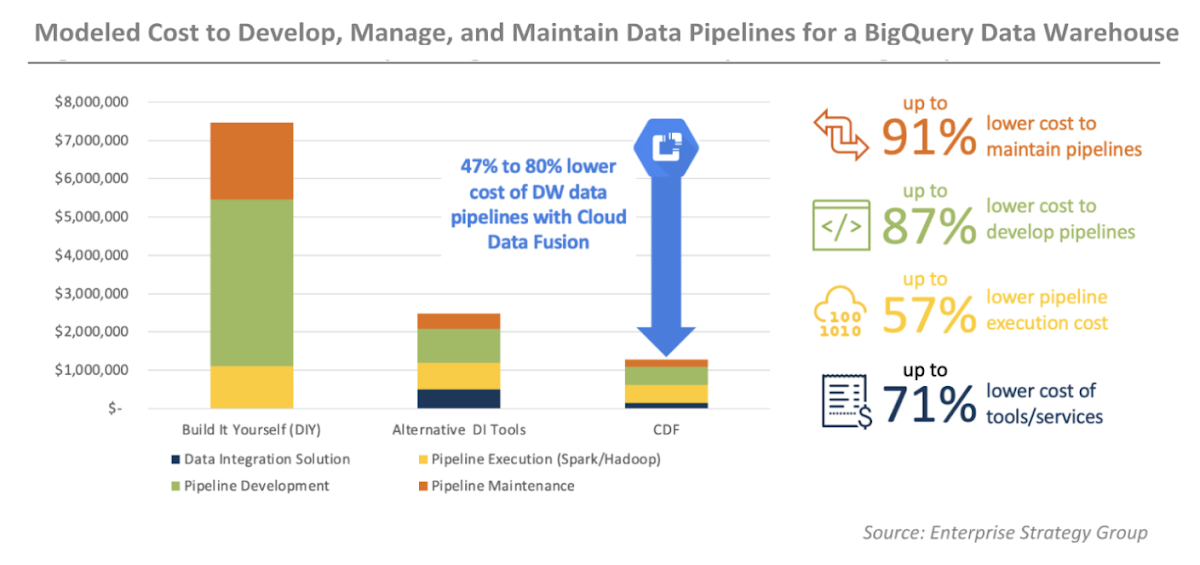Lower TCO for managing data pipelines by 80% with Cloud Data Fusion
Nidhi Modh
Product Manager, Data Analytics, Google Cloud
Try Google Cloud
Start building on Google Cloud with $300 in free credits and 20+ always free products.
Free trialIn today’s data-driven environment, organizations need to use various different data sources available in order to extract timely and actionable insights. Organizations are better off making data integration easier to get faster insights from data rather than spending time and effort in coding, testing complex data pipelines .
Recently, Google Cloud sponsored Enterprise Strategy Group (ESG) on two whitepapers, conducting deep dives into the need for modern data integration, and how Cloud Data Fusion can address these challenges including the economic value of using Cloud Data Fusion as compared to other alternatives available.
Challenges in Data Integration
Data integration has notoriously been the greatest challenge data-driven organizations face as they work to better leverage data. On top of migrating certain, if not all, workloads to the cloud, areas like lack of metadata, combining distributed data sets, combining different data types, and handling the rate at which source data changes are directly leading to organizations prioritizing data integration. In fact, this is the reason that improving data integration is where organizations expect to make the most significant investments in the next 12-18 months1. Organizations recognize that by simplifying and improving their data integration processes, they can enhance operational efficiency across data pipelines while ensuring they are on a path to data-driven success.
Cloud Strategy and Data Integration
Based on the ESG report, the cloud strategy impacts the way in which organizations implement and utilize data integration today. Organizations can choose from, single cloud, multi-cloud or hybrid cloud strategy and in doing so, choosing the right data integration option can give organizations freedom and flexibility. Irrespective of the cloud strategy, organizations are embracing a centralized approach to data management to not only reduce costs but also to ensure greater efficiency in the creation and management of data pipelines. By standardizing on a centralized approach, data lifecycle management is streamlined through data unification. Further, with improved data access and availability, data and insight reusability are achieved.
Cross-environment integration and collaboration
Organizations are increasingly in search of services and platforms that minimize lock-in while promoting cross-environment integration and collaboration. As developers dedicate more time and effort into building modern applications heavily rooted in data, knowing the technology is underlined by open-source technology provides peace of mind knowing the application and underlying code can be run anywhere the open-source technology is supported. This desire for open-source technology extends to data pipelines too, where data teams have dedicated hours to optimally integrate a growing set of technologies and perfect ETL scripts. As new technologies, use cases, or business goals emerge, enabling environment flexibility ensures organizations can embrace data in the best way possible.
Cost savings with Cloud Data Fusion
ESG conducted interviews with customers to validate the savings and benefits that they have seen in practice and used these as the assumptions to compare Cloud Data Fusion. Aviv, a senior validation analyst with ESG has taken two use cases, building data warehouse and building data lake and compared on-prem, build yourself with Cloud Data Fusion. The research shows that customers can realize cost savings up to 88% to operate a hybrid cloud data lake and up to 80% to deploy, manage, and maintain data pipelines for cloud-based enterprise data warehouses in BigQuery. Here is a sneak peek into ROI calculations for building Data Warehouse in BigQuery using Cloud Data Fusion vs other alternatives.


The full whitepapers contain even more insight, as well as a thorough analysis of the data integration tools’ impact on businesses and recommended steps for unlocking its full potential. You can download the full reports below:
Accelerating Digital Transformation with Modern Data Integration
The Economic Benefits of Data Fusion versus other Alternatives
Additionally, try a quickstart, or reach out to us for your cloud data integration needs.
1. ESG Master Survey Results, 2021 Technology Spending Intentions Survey, December 2020



